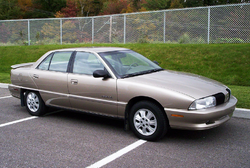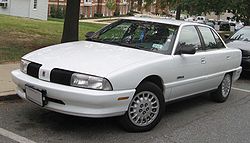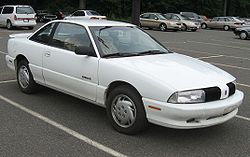- Oldsmobile Achieva
-
Oldsmobile Achieva 
1997 Oldsmobile Achieva SL sedanManufacturer Oldsmobile Production 1992–1998 Assembly Lansing, Michigan, United States Predecessor Oldsmobile Cutlass Calais Successor Oldsmobile Alero Class Compact Body style 2-door coupe
4-door sedanLayout FF layout Platform GM N platform Engine 2.3 L Quad-4 I4
2.4 L LD9 I4
3.1 L 3.1
3.3 L 3300 V6Transmission 5-speed manual
3-speed Turbo-Hydramatic 125 automatic
4-speed automaticWheelbase 103.4 in (2,626 mm) Length 1992–95: 187.9 in (4,773 mm)
1996–98: 187.8 in (4,770 mm)Width 1992–93: 67.5 in (1,715 mm)
1994–98: 68.6 in (1,742 mm)
1996–98 Sedan: 68.1 in (1,730 mm)Height 1992–93: 53.2 in (1,351 mm)
1994–98: 53.5 in (1,359 mm)Related Buick Skylark
Chevrolet Malibu
Oldsmobile Cutlass
Pontiac Grand AmThe Oldsmobile Achieva was introduced for the 1992 model year and was a front-wheel drive, compact car[1] based on the GM N-body platform which it also shared with its siblings the Pontiac Grand Am and Buick Skylark. The Achieva replaced the GM N-body Cutlass Calais after the Calais' final 1991 model year, and ended production after the 1998 model year.
Contents
Overview
The Achieva was a compact car produced by the General Motors' Oldsmobile division from 1992 to 1998 and was available as a sedan or coupe. It was offered in four different trim levels during its production run; S, SC, SL, and SCX. The engines available throughout the production run included different versions of the Oldsmobile-developed Quad 4, ranging from the high-output LGO (RPO code) version and an even higher output special "W41" version of the LGO Quad 4 (used in the SCX models), a normal DOHC LD2 version of the 2.3 L Quad 4, the SOHC "Quad OHC" variant, as well as the later Quad 4-based "2.4L Twin Cam" LD9. A pair of V6 engines were also offered including the Buick-sourced 90° 3.3 L "3300" V6 that was later replaced by Chevrolet's 60° 3.1 L "3100" V6. While a five-speed manual transaxle was initially offered as the standard base transmission, most Achieva models were sold with three-speed or four-speed automatic transaxles. The Achieva was last sold in model year 1998, after which it was replaced in the Oldsmobile lineup by the Alero for the 1999 model year.
Initial Production
The Achieva was first seen as a concept car at the 1991 Chicago Auto Show and was said to replace Oldsmobile's compact Calais models. The Calais and Achieva both share the same basic front wheel drive GM N-body architecture including identical wheelbase length. The Achieva started regular production for the 1992 model year. It was offered in four different trims: S and SL that were both available in two and four-door model, and the sporty SC and SCX coupe. The S as the standard model has a 120-horsepower 2.3-liter Quad OHC 4-cylinder. The SL uses the DOHC 160 horsepower (120 kW) Quad 4 engine that was made optional on the S model. A 160-horsepower 3.3 L V6 engine was optional for the SL. The SC coupe had a standard 180 horsepower (130 kW) high-ouput Quad 4 with 5-speed manual transmission or a 3 speed automatic with the 3.3 L V6 being an option. An interesting design feature for the time, exclusive to the Achieva sedan, was the presence of rear fender skirts. While still used at the time, they were mostly found on traditional large size cars, not compacts. The similar Buick Skylark sedan and coupe built on the the same GM N-body platform also had rear fender skirts.
SCX W41
The SCX W41 coupe was introduced by Oldsmobile in 1992 and offered through 1993. It replaced the previous Cutlass Calais 442 W41 as the best handling, highest power output compact car in the Oldsmobile's lineup as well as being the last performance "W-Machine" Oldsmobile would offer. The SCX is a higher-performance version of the SC (Sports Coupe) and as such utilized the SC's deeper front bumper cover with standard fog lamps, lower body side cladding, rear bumper cover with dual exhaust tip cut-outs, as well as a unique W41-specific silver colored stripe around the lower body moldings, "W41" decals on the front fenders, and "Achieva SCX" decals at the leading edges of the doors. Other appearance changes for the SCX W41 package included the addition of a 140 mph speedometer in place of the standard 120 mph unit as well as a tachometer indicating the higher 7200 rpm red line.
Performance modifications primarily differentiated the SCX from the SC models and were designed to make the SCX competitive for use in showroom stock racing series such as the IMSA Firehawk and SCCA GRAND-AM World Challenge. This included the move to smaller diameter yet wider V-rated 215/60R-14 Goodyear Eagle "Gatorback" tires on 14x6.5 inch cast aluminum wheels (compared to the SC's 205/55R-16 on 16x6 inch wheels) and different suspension components on the SCX-specific FX3 RPO coded suspension. The suspension changes included larger diameter direct-acting front sway bar over the base Achieva, a wider rear axle with dual rear sway bars, "Computer Command Ride" (CCR) electronically adjustable struts and shock absorbers, as well as higher spring rates and bushing changes. (A similar CCR electronic suspension was also offered as an option on the Achieva SC as well as the platform-mate Buick Skylark and works similar to the systems offered on Cadillac and Corvette models of the time.)
The SCX's powertrain included the highest output naturally aspirated four-cylinder engine GM had produced up to the time, the 190-horsepower, 160 ft-lbs. torque W41 version of Oldsmobile's Quad 4 engine. Compared to the SC's standard high-output, 180-horsepower LGO Quad 4, the W41 version of the LGO Quad 4 was fitted with different camshafts, a low restriction exhaust system with dual mufflers and a special engine computer calibration for the ignition and fuel systems that also raised the engine's redline to 7200 rpm. This engine was complemented by a unique version of the Getrag-licensed, GM-Muncie built Getrag 282 five-speed transaxle with special second and fifth gears as well as a different final drive ratio for quicker acceleration and better gearing to keep the engine in its power band.
The production numbers for the Achieva SCX in 1992 totaled 1146 cars made with (6) C41 RPO code A/C-delete racing models as follows: (1) bright red, (2) medium garnet red, (1) aqua, (1) blue, and (1) white cars. The normal C60 RPO code models included (472) bright red, (42) medium garnet red, (218) black, (196) aqua, (50) neon blue, (151) white, and (11) gray cars.
The 1993 SCX production totaled 500 cars produced including (5) C41 RPO code A/C-delete racing models as follows: (1) bright red, (1) aqua, and (3) white cars. The normal C60 RPO code models included (128) black, (191) bright red, (20) medium garnet red, (73) aqua, (8) neon blue, (70) white, and (5) majestic pearl cars.
The RPO code for the vehicles are located on a sticker under the carpet inside the trunk near the spare tire cover. The "W41" package will always have either "C41" or "C60" to specify non-air conditioned or air conditioning equipped cars. The C41 equipped W41 models were a special order option designed for race car builders and included a baffled fuel tank, the previously mentioned air-conditioning delete, as well as a different calibration in the computer that allowed for a higher 7400 rpm redline. The cars should also have included a Torsen, helical gear style limited slip differential which would have been delivered not installed in the trunk of the car.
Production changes
During the second year of production, all 1993 Achieva models saw a reduction in power across the engine lineup due to changes made to comply with stricter emission requirements. This resulted in all engines and trims levels 5 horsepower (3.7 kW) lower for 1993, including the SCX which was down to 185 hp for its final year (primarily due to exhaust port changes to the cylinder head). Other changes for 1993 included a revised front engine mount and changes to the Quad 4 block casting to address criticism for that engine's NVH characteristics. For 1994, a driver-side airbag was added as one of the standard features. The Buick-developed 3.3 L "3300" V6 was changed to a Chevrolet-designed 3.1 L "3100" V6. All 1994 models through end of production have automatic transmissions.
In 1995, all Achieva trims were reduced to one: S coupe and sedan, which is divided into two groups according to equipment: Series I and Series II. Driver-side airbag, anti-lock brakes, and an air conditioner are standard to every version. The Quad 4 with 150 horsepower (110 kW) and 3.1-liter V6 with 155 horsepower (116 kW) were the only available engines for 1995, the other two from the previews years were dropped.
The 1996 models add more standard features to include standard air conditioning, daytime running lamps, and a new dash panel featuring revised gauges with passenger-side airbag. The new base engine was a 2.4-liter four-cylinder "2.4L Twin Cam" that replaced the 2.3-liter Quad 4. There were little changes other than reduced trim levels and options for the final two model years.
The final model year for the Achieva was 1998 with the majority of sales going to fleet customers. The Achieva was complemented at the end of its production run by the slightly larger Cutlass which overlapped Achieva production from 1997 to 1999. Both models were replaced in the Oldsmobile lineup by the Oldsmobile Alero in 1999. The Cutlass and Alero were built on a new front wheel drive GMX130 N-body platform that shared little chassis and platform architecture with the previous Achieva.
Achieva production ended on December 4, 1997.[citation needed]
Trim levels and engines
Trim levels
4-Door Sedan (1992–1998):
- S - 1992–1995
- SL - 1992–1994; 1996–1998
2-Door Coupe (1992–1997):
- S - 1992–1995
- SC - 1992–1993
- SCX - 1992–1993
Engines
- 1992–1994 Quad OHC 2.3 L (140 in³) I4, 115 hp (86 kW) and 140 ft·lbf (190 N·m)
- 1992–1995 Quad-4 2.3 L (140 in³) I4, 155-160 hp and 150 ft·lbf (200 N·m)
- 1992–1994 Quad-4 2.3 L (140 pin³) I4, 175-180 hp and 160 ft·lbf (220 N·m)
- 1992–1993 Quad-4 2.3 L (140 in³) I4, 185-190 hp and 160 ft·lbf (SCX W41)
- 1992–1993 3300 3.3 L (204 in³) V6, 160 hp (120 kW) and 185 ft·lbf (251 N·m)
- 1994–1998 3100 3.1 L (191 in³) V6 160 hp (120 kW) and 185 ft·lbf (251 N·m)
- 1996–1998 LD9 2.4 L (146 in³) "Twin Cam" I4, 150 hp (110 kW) and 150 ft·lbf (200 N·m)
References
- ^ "1997 Oldsmobile Achieva Detailed Pricing and Specifications". Autos.msn.com. 2010-02-22. http://autos.msn.com/research/vip/overview.aspx?year=1997&make=Oldsmobile&model=Achieva&trimid=-1. Retrieved 2010-12-27.
Cars 40 • 53 • 66 • 88 • 98 • 442 • Achieva • Alero • Aurora • Curved Dash • Custom Cruiser • Cutlass • Cutlass Calais • Cutlass Ciera • Cutlass Cruiser • Cutlass Supreme • F-85 • Firenza • Intrigue • Jetstar I • Limited Touring • Omega • Series 60 • Series 70 • Oldsmobile Series 90 • Starfire • Toronado • Vista CruiserMinivans / SUVs Concepts and Prototypes F-88 (1954) • Golden Rocket (1956) • Aerotech I (1987) • Aerotech II (1989) • Tube Car (1989) • Aerotech III (1989) • Expression (1990) • Antares (1995) • Alero Alpha (1997) • Recon (1999) • Profile (2000) • O4 (2001)« previous — Oldsmobile road car timeline, 1980s–2004 Type 1980s 1990s 2000s 0 1 2 3 4 5 6 7 8 9 0 1 2 3 4 5 6 7 8 9 0 1 2 3 4 Compact Starfire Firenza Omega Cutlass Calais Achieva Alero Mid-size Cutlass Cutlass Ciera Cutlass Cutlass Cruiser Cutlass Cruiser Cutlass Supreme Cutlass Supreme Intrigue Full-size Eighty-Eight Eighty-Eight Eighty-Eight Ninety-Eight Ninety-Eight Ninety-Eight Regency Custom Cruiser Custom Cruiser LSS Aurora Aurora Personal luxury Toronado Toronado Minivan Silhouette Silhouette SUV Bravada Bravada Bravada Categories:- Compact cars
- Coupes
- Front wheel drive vehicles
- Oldsmobile vehicles
- Sedans
- 1990s automobiles
- Vehicles built in Lansing, Michigan
- Vehicles introduced in 1992
Wikimedia Foundation. 2010.



